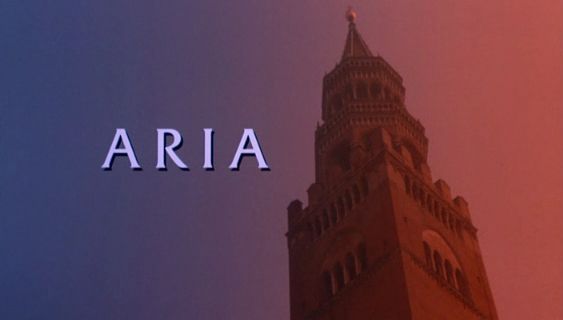ARIA

In the 1987 movie 'Aria' ten celebrated directors from around the world were assigned the task of making one short film each using an aria from ten different operas. Although the results were mixed I've always been impressed with the ambition of the project and the opportunity it presented in re-working the themes and stories of the selected operas in a wholly unique and cinematic way.
Franc Roddam (director of 'Quadrophenia') based his short film for 'Aria' on the famous 'Liebestod' (Love death) from Wagner's 'Tristan und Isolde' and it made a vivid impression on me due in part to its dreamy road movie montage crossing the Arizona desert into Las Vegas as well as the sensual suicide lovers sequence that culminates in their eventual slashing of their wrists in a bath tub just like something out of Ôshima's 'In The Realm Of The Senses." This cinematic neon-soaked re-imagining of Wagner's "love death" felt wholly appropriate in the way it matched the epic nature of the music it was inspired by as well as simultaneously giving it a fresh, modern interpretation. It was I suppose what you might call opera for the MTV generation.
Ken Russell's exotic fantasy set to Puccini's 'Nessun Dorma' also held a strange if somewhat kitsch fascination for me with its bizarre Egyptian-inspired dream sequence that cuts to a woman undergoing intensive surgery after being involved in a horrific car crash. The alternating between dream and reality is effective if a bit crude in execution. This was definitely more 1970's 'Mahler' Russell than 1960's 'Elgar' Russell.
Jean Luc Goddard, Robert Altman, and Charles Sturridge also contribute interesting shorts for 'Aria' themselves but the one segment I believe to be most successful of the ten is Derek Jarman's contribution set to "Depuis le jour" from Charpentier's 'Louise'. In this poignant sequence, an old lady (a former opera singer) takes imagined stage bows as cine-reel memories of her younger self (Tilda Swinton) flash before her. The intercutting between the end of the singer's life and her happiest memories seems especially effective in both its fairly literal approach to conveying the text of the aria "What a beautiful life! Oh! I'm so happy! ... utterly happy! And I'm trembling delightfully from the charming memory of the first day of love!" but also in its beautifully sincere honouring of the ethereal melancholic atmosphere of Charpentier's music.